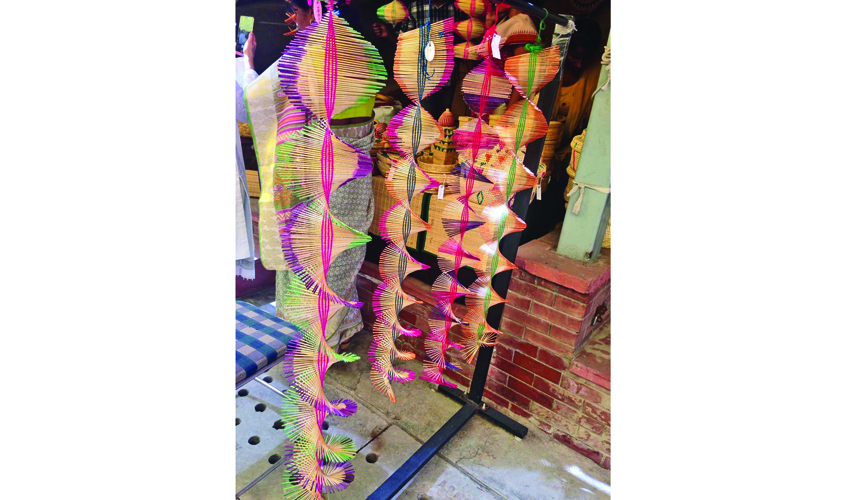The women and girls of Jagatsinghpur’s Thailo village are well-known for their amazing products. They spend on an average 4-5 hours working on various products. Their typical day begins with completing household chores after which they spend time on the craft. For women in that area, this is the only source of income. One such example is that of Alka Bala. Alka won the 2005 Kamala Devi Award for excellence in Golden Grass Craft, awarded by the Delhi Draft Council. But her journey was not that simple. She was not allowed to work after she got married.
Unnayan promotes “Janani” and its golden grass handicrafts. Kaincha grows in plenty in the periphery of the village and it’s strong enough to hold things. It was in the year 2000 that 22 women from Thailo first got together to form a self-help group with the support of Unnayan, a Bhubaneswar-based development organisation that works to empower marginalised communities with employable skills. It brought in designers and entrepreneurship experts to train the women in ways to convert their talent into a profitable venture.
Although the process of making the handicraft products is strenuous, the women are thrilled to get an opportunity to gain financial independence. The SHG members go out in groups and often have to wade through neck-deep water to reach areas where this grass flourishes. Once back, the collected stalks are carefully splintered into two pliable strips and left to dry out under the sun. In a single trip, the women manage to get anywhere between five and 15kg of grass. Once the federation, which is currently being run from a small rented room in the village, gives them an order, they get down to making the products. The golden grass handicraft has not just empowered the women in this region, but it has made them famous too. The women are using this sturdy golden grass to craft stationery items like files, trays, pencil cases, book stands and notebook covers to interior decoration and other stuff like lamp shades, window screens, dining table accessories, boxes, bags, hand fans and baskets. These items have now become immensely popular around the country. This handicraft is well received even by foreign
The women are using this sturdy golden grass to craft stationery items like files, trays, pencil cases, book stands and notebook covers to interior decoration and other stuff .
The demand for these products is only growing, but then so are the challenges, which is really beyond the control of the women. Inclement weather conditions, brought on by climate change, have severely affected the growth and availability of kaincha, forcing women to scale down their work. The grass is usually collected after the first monsoon rains in the months of July, August and September — but the insufficient rainfall or freak flooding have severely impacted its growth. The summers have also been unbearably hot, which has impacted the collections. Bad weather makes the grass unfit for weaving. Even if they do manage to make their products in these weather conditions, the quality of the product is not up to the mark. Added to the woe is the changing mindset of the second generation. “But the second generation does not want to continue as this work doesn’t get easy and does not get fast money. There is not just migration, but also alternate sources of income that the youth are exploring,” a joint statement by Sarojini Das and Rita, advisor and secretary of Janani Federation respectively, said.

It went on: “Technologically, there is no alternative to increasing the production of kaincha when there’s unfavourable climatic condition. Floods dampen the strength of the fiber which is majorly found in coastal areas. In case of flood-like situations. So the only alternative is either to use the stocked grass or change the areas from where the sourcing of grass is done.”
Therefore, to revive this dying art, Dastkar has to come to the forefront. Started in 1981, Dastkar affects the lives of more than 1 lakh artisans every year working with over 600 craft groups across 29 Indian states. They strongly believe in crafts as a catalytic tool for social and economic empowerment and earning and are trying to innovate indigenous products according to the needs of the urban market.
Speaking about this, Shelly Jain, Head (Personnel and Programme), Dastkar, says, “Over the years, Dastkar has been able to use craft as a powerful catalytic tool for social and economic empowerment and often, the only economic opportunity for many. Unnayan is one such successful example of how crafts are liberating and empowering.”
“We attend their fairs regularly, which has given us better understanding of the consumer, and also design inspirations. This association has opened doors for us, and we have even received international orders from Canada, Hong Kong and Japan. For example, we are attending the Festival of Lights in Delhi so that we can also create visibility of the craft in Indian audience,”says Das and Rita.
Jain adds: “Through bazaars such as Festival of Lights, we bring specially curated hand-crafted products to the urban audience. Amid the many machine made items flooding the market, the idea is to celebrate the festive season with decoratives, handlooms and gift items for your loved ones, made using the traditional arts and crafts of India.’’
Products of Unnayan will be available in Delhi until 26 October at Festival of Light, which is being organized at Nature Bazaar, Andheria More, near Chattarpur Metro station.

